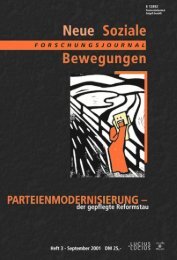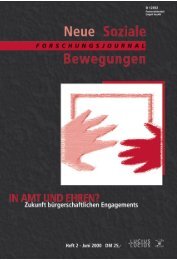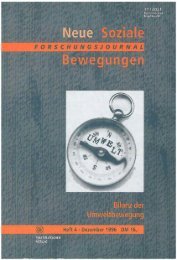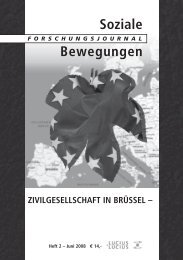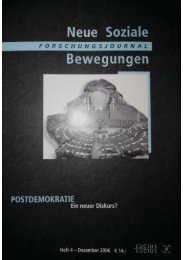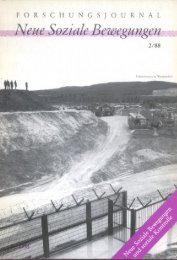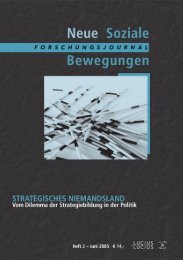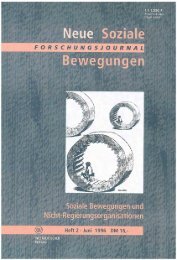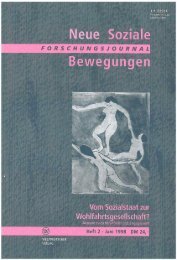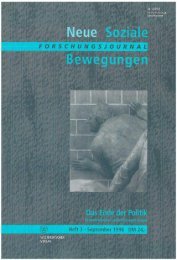Vollversion (5.41 MB) - Forschungsjournal Soziale Bewegungen
Vollversion (5.41 MB) - Forschungsjournal Soziale Bewegungen
Vollversion (5.41 MB) - Forschungsjournal Soziale Bewegungen
Sie wollen auch ein ePaper? Erhöhen Sie die Reichweite Ihrer Titel.
YUMPU macht aus Druck-PDFs automatisch weboptimierte ePaper, die Google liebt.
FORSCHUNGSJOURNAL NSB, JG. 11, HEFT 4, 1998 ^^Mmml<br />
ABSTRACTS<br />
Kai-Uwe Hellmann: Protest and violence - in sight of the structural strains-approach,<br />
FJ NSB 4/98, pp. 20-28<br />
In the first contribution, Kai-Uwe Hellmann raises the question whether social-structural conditions<br />
can be identified under which protest generates violence. He presents the general contours<br />
of the ,structural strain' approach and proposes adistinction between power and violence. Drawing<br />
on Wilhelm Heitmeyer's research approach, he shows how social structure connects to violence.<br />
In conclusion, only a multidimensional approach seems capable to do justice to the complex<br />
relation between protest and violence.<br />
Klaus Eder: Protest and symbolic violence. On the logic of mobilizing collective<br />
identities, FJ NSB 4/98, pp. 29-40<br />
Klaus Eder addresses the question to what extent the mobilization of collective identities is related<br />
to symbolic relations of power and violence. Drawing on Parsons, he defines symbolic power as<br />
the blocking of communication chances. He then goes on to connect symbolic power to processes<br />
of symbolic exclusion, in which the drawing of boundaries leads to exclusion in terms of belonging,<br />
recognition, and collective identity construction. This brings Eder to the hypothesis that physical<br />
violence increasingly gives way to symbolic violence, because of the increasing relevance of a<br />
politics of identity, for instance in ethnie conflicts.<br />
Reinhard Kreissl/Fritz Sack: Framing - The cognitive-social dimension of social<br />
protest, FJ NSB 4/98, pp. 41-54<br />
Reinhard Kreissl and Fritz Sack begin their contribution with a discussion of the development of<br />
the ,framing' approach, and give a brief overview of recent research on violence. They then analyze<br />
the relevance of framing for our understanding of violence, both form a social research and from<br />
a mass media perspective. In a next step, they offer a critical discussion of the myth of the monopoly<br />
on violence, the pacifying effects of which tend to be seen as the core function of the State. The<br />
authors conclude by pointing out a number of methodological weaknesses in the framing model,<br />
which are particularly aggrevating for the analysis of the relation between protest and violence.<br />
Ekkart Zimmermann: Resource mobilization and violence, FJ NSB 4/98, pp. 55-67<br />
Ekkart Zimmermann's contribution focusses on the role of resource mobilization in the genesis of<br />
violence. He presents a thoughtful discussion of the strengths and weaknesses of the resource<br />
mobilization approach, placing it in the context of its conceptual predecessor ,relative deprivation',<br />
and its offspring ,political opportunity structure'. Drawing on this discussion, Zimmermann<br />
discusses the issue of violence and presents new results from his study of the propensity to protest<br />
and violence in East and West Germany in 1993 and 1995. In this context, he particularly<br />
emphasizes the role of the State in the escalation of violence.



